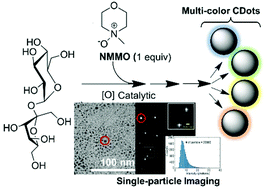Carbon dots with induced surface oxidation permits imaging at single-particle level for intracellular studies†
Abstract
For robust single particle optical detection, a high sensitivity in photoluminescence (PL) of Carbon Dots (CDs) must be achieved. PL sensitivity can be successfully correlated with their surface chemistry but requires high synthetic control without altering their basic surface properties. Here we describe conditions for the controlled synthesis of CDs that resulted in a PL sensitivity at the single-particle level. We report that a stoichiometric catalyst N-methyl morpholine-N-oxide (NMMO) can be used as a ‘sacrificial’ single additive to aid nanoscale surface oxidation. A 24 h NMMO-mediated oxidation increased coverage of oxidized nanoscale surface 3% to 20.9%. NMMO-oxidized CDs (CD-NMMOs) display superior particle brightness, as evidenced by the increase of light absorbance and an enhancement of quantum yield which is characterized by a series of physicochemical and biophysical experiments. We also demonstrate that CD-NMMOs is well suited for intracellular and single-particle imaging.



 Please wait while we load your content...
Please wait while we load your content...